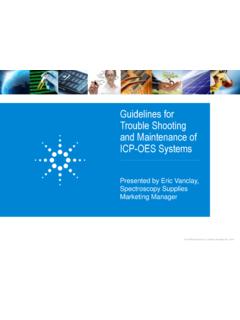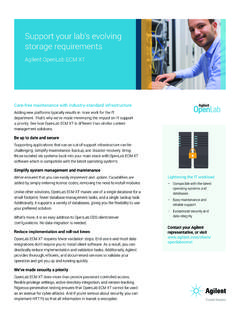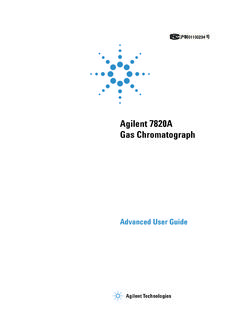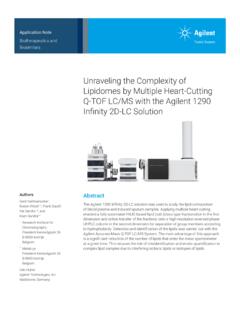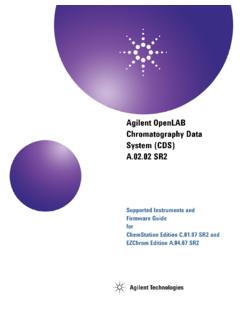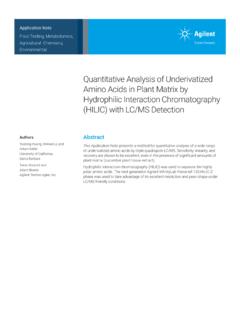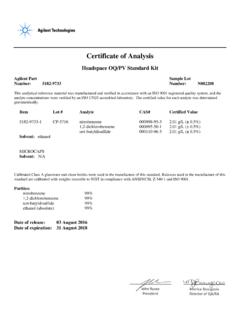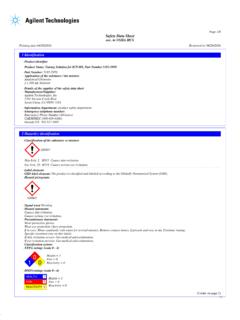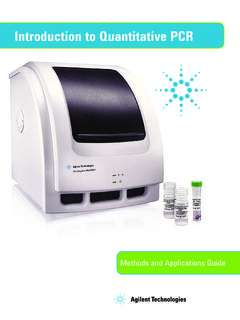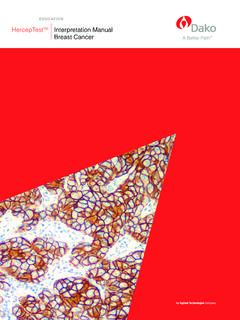Transcription of Guidelines for Trouble Shooting and Maintenance
1 Guidelines forTrouble Shootingand Maintenanceof ICP-MS SystemsPresented by Dr. Gareth PearsonICP-MS Supplies Product ManagerICP-MS Maintenance & Trouble Shooting (update 05/2018)The Agilent Atomic Spectroscopy LineupAn Instrument for Any Customer Application!May 2018 ICP-MS Maintenance & Trouble Shooting255B Flame AA 240FS/280FS Flame AA 240Z/280Z Furnace AA 4210 MP-AES5110 ICP-OES 7800 ICP-MS 7900 ICP-MS NEW! 8900 ICP-QQQA gilent 7800 and 7900 ICP-MSQuadrupole ICP-MS (ICP-QMS)Agilent 7800 and Agilent7900 High matrix tolerance with HMI/UHMIHe mode removes common polyatomicsWide dynamic rangeApplications from routine to researchAgilent 8900 ICP-QQQT riple Quadrupole ICP-MS(ICP-QQQ)
2 Agilent 8900MS/MS for controlled reaction chemistryUnmatched interference removalHigh sensitivity and low backgroundsSuperior Abundance SensitivityAgilent ICP-MS at a GlanceICP-MS Maintenance & Trouble Shooting3 May 2018 Top 5 Tips for Flawless ICP-MS PerformancePrevent nebulizer blockagePay attention to the interface conesKeep it cleanSet high standardsDon t neglect the pump tubingICP-MS Maintenance & Trouble Shooting4 May 2018 How to Prevent Nebulizer Blockage?Micro-flow nebulizers Zero tolerance to undissolved solids Plugging of annulus and/or capillaryRinse at least 10 minutes with a reagent blank before extinguishing plasmaFilter/Centrifuge/gravitational settlingUse only lint less wipesAutosampler enclosuresAutosampler probe heightThink PREVENTION modified from Pneumatic Nebulisers and Spray Chambers for inductively coupled plasma Spectrometry.
3 A Review, Part 1. Nebulisers by Barry Sharp, JAAS, , p. 613-652, provided by MeinhardGlassblowing Products ICP-MS Maintenance & Trouble Shooting5 May 2018 Improve Efficiency of Sample FilteringMost users shouldfilter samples prior to analysis Reduces Maintenance and downtime from blockages in the sample introduction systemAgilent Captiva syringe filters provide an efficient solution Captiva filters provide the industry s highest flow rates and loading capacities Available in a variety of membrane types and pore sizes, to suit your application Recommended for spectroscopy applications: Captiva Premium, 100/pk PTFE, Pore, 15mm dia. (5190-5085) or 25mm dia. (5190-5087) Captiva Econofilters, 1000/pk PTFE, Pore, 13mm dia.
4 (5190-5266) or 25mm dia. (5190-5268) Maintenance & Trouble Shooting6 May 2018 Instructions for use Captiva Syringe Maintenance & Trouble Shooting7 May 2018 Improve Efficiency from Digestion to Filtration to AnalysisThe FilterMate Filtration System provides a convenient, economical method for digestion, filtration and analysis, improving sample preparation efficiency by eliminating transfers. Weigh sample directly into the vessel and use the graduations to accurately add reagents Digest in the Hot Block, Dilute to volume, Filter directly and place on the autosampler rack for analysis190048000 FilterMate 2 micron PTFE, 100/pk190048100 FilterMate micron PTFE, 100/pk190047900 Digestion Tubes, Polypropylene for 36-and 54-well hot block, 500/ Maintenance & Trouble Shooting8 May 2018 Cleaning the NebulizerNever sonicateor attempt to clean with wire!
5 For normal cleaning: Soak in 5% nitric acid for ~10 remove a nebulizer blockage: Use a dedicated nebulizer cleaning tool to force methanol solution through the tip; OR Reverse pump the nebulizer with the tip in solvent; OR Apply suction from the wide end of the capillary using a vacuum aspirator; OR Apply high pressure clean air via a tubing snugly fitted over the nebulizer tip (use with caution)For salt deposits: Soak the nebulizer overnight in a beaker of 25% alkaline lab detergent. Rinse with pure waterFor stubborn deposits: Soak the nebulizer overnight in conc. nitric acid. Use a pipette to ensure there are no air bubbles in capillary. Rinse with pure waterSuctionPressureNebulizer cleaning toolAgilent pnG3266-80020 Maintenance & Trouble Shooting9 May 2018 Visually inspect the cones-Agilent s LED measuring magnifier (pn5190-9614) is a tool to help user s achieve optimum ICP-MS instrument performance and maximum cone life ICP-MS users can use the magnifier to.
6 -Visually inspect a cone to evaluate its condition( check for excess matrix build-up at the tip) -Check if a cone has a damaged orifice and needs to be replaced ( enlarged or damaged orifice)-Confirm if Maintenance procedures and cleaning have been successfulPay attention to the Interface ConesICP-MS Maintenance & Trouble Shooting10 May 2018 Why and When to Clean Your Interface Cones?Close up of sampler cone after measuring 75 undiluted sea water samples using HMIThe necessity to clean the cones depends on your (in)tolerance limits for: Sensitivity Long term precision Elevated background (cps) Interface vacuum changingOther reasons to clean the cones? If there is an excessive build up of deposits on the orifice(should be circular and free of deposits) If the orifice of the cone is blocked / non-circular / unusually discoloredIf analyzing the same type of samples, clean to remove only superficial deposits.
7 Ultrapure water clean may be all that is requiredA conditioned cone has a uniform coating that leads to long term stabilityIf analyzing different sample types where a major element in the first sample type is a trace element in the second, more than one cleaning step is requiredICP-MS Maintenance & Trouble Shooting11 May 2018 What s the Right Way to Clean Interface Cones?Routine Cleaning:Simple clean with pure water Dip a cotton swab (pn9300-2574) in pure water and clean both sides of the cone Rinse with pure water Ultrasonicate the cones in pure water for >5 mins (typ. 20 mins) Repeat as required (aim for water to stay clean)Only if performance is still not satisfactory, clean with a 2% Citranoxsolution (pn5188-5359)(NOT MORE THAN 2%) Ultrasonicate in a 2% Citranoxsolution for max.
8 2-3 mins Rinse with pure water Ultrasonicate in pure water for >5 Maintenance & Trouble Shooting12 May 2018 What s the Right Way to Clean Interface Cones?ONLY For more severe contamination:Clean with a 2% nitric acid solution Dip a cotton swab in 2% HNO3and clean both sides of the cone(DO NOT SOAK IN ACID) Rinse with pure water Ultrasonicate in pure water for2 -3 mins Rinse with pure water Ultrasonicate again in pure water for an additional 2 -3 minsPitted nickel cone from effect of HNO3soak (left side) and clean machined metal on Maintenance & Trouble Shooting13 May 2018Re-installing the Cleaned Cones Check the condition of the graphite gasket and replace if necessary Refit the skimmer cone using the removal tool Refit the sample cone and tighten by hand Check the vacuum levels to confirm correct installation Interface pressure.
9 500 Pa (~4 torr, atm) Analyzer pressure: Pa (~ x10-5torr, 2 x10-8atm)ICP-MS Maintenance & Trouble Shooting14 May 2018 Common Interface Cone IssuesCones are fragile (esp. skimmer cone) Handle with care! Poor handling, harsh cleaning or physical abuse can irreversibly damage cones Never place tip down on any surface or during cleaning Don t try to clean back to original conditionCheck that you re using the right skimmer base Increases deposition on the cone Using the wrong skimmer base can overheat and damage the cone Ni cones use the stainless steel base Pt cones use the brass skimmer baseCondition new or cleaned cones prior to use Reduces drift due to initial deposition of sample matrix on the clean cone surface Aspirate your highest matrix sample for >30mins and then your blank / rinse solution for 10 mins.
10 Alternatively aspirate 6020 Interference Check solution A (pn5188-6526) diluted 10 times in General Purpose mode for 30 mins.; follow with a 5% HNO3solution for 10 coneDamagedconeICP-MS Maintenance & Trouble Shooting15 May 2018 Maintenance & Trouble Shooting16 May 2018 Are You Using the Right Interface Cone?Skimmer cone, Nickel Skimmer base, Stainless SteelSkimmer cone, Platinum Skimmer base, BrassType of ConeFor which Model ICP-MS?Skimmer BaseRequiredRecommendedApplicationsNicke l sample / skimmer conesStandard on 7500a/i/c/ce/cx, 7700x/e, 7800/7900 and 8800/8900 with x-lensStainless steelSuitable for most common thermal and chemical resistanceProvides most economical operationTypically use 3-5/year (based on ~350 samples/day)Nickel plated sampling coneOptional for all 77/78/7900 and 88/8900 models-For samples containing > HCl, or for routine operation with (U)HMI with max.
